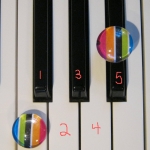Transposing Up a Whole Step: Chord Structure
Tuesday, August 16th, 2016The following free pdf of transposing examples will aid the church pianist in changing from one song to the next during prelude or for background invitationals.
Keep in mind, this free pdf only showcases the chord structure for transposing up a whole step. A more detailed visual sheet with moving notes will follow in the next article on transposing up a whole step to a different song or same song/different verse.
Editor notes for this free pdf of transposing examples:
- Transposing up a whole steop
- 3/4 time signature hymns only
- Four examples shown in: E flat Major, F Major, G Major and A Major (each key signature is a whole step apart…one letter name higher than previous key)
Click on the title below to download the chord structure chart for transposing up a whole step for hymns in 3/4 time.


